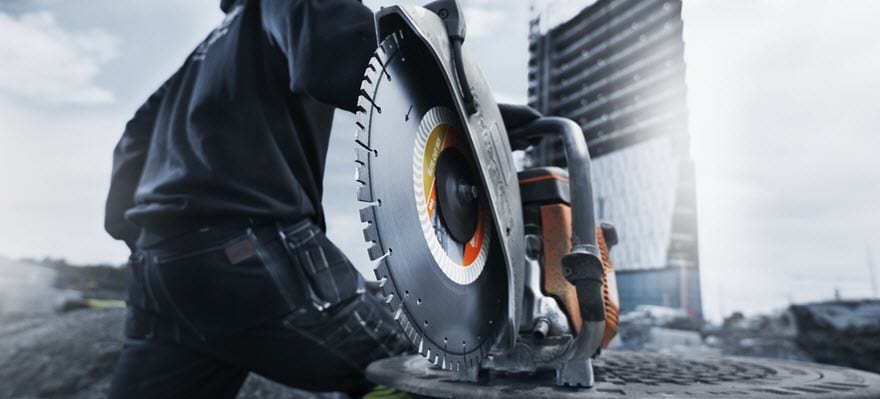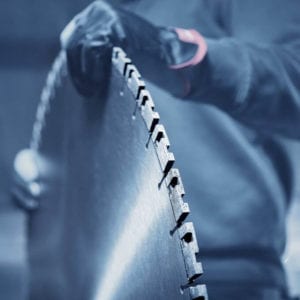You want to make sure you do everything possible to extend the life of your diamond cutting blade. Diamond blades vary in size, style, and composition; however, the general best practices mentioned in this article are appropriate for all types of diamond blades.
DO: Use a hard bond to cut softer materials and a soft bond to cut harder materials
It sounds strange, but it has to do with the process of the diamonds being ground down while the blade spins through the material, sloughing off diamonds to reveal another diamond layer.
Hard bond → Soft material
A harder bond holds diamonds in place longer – meaning it’s more effective when grinding through softer material.
Soft bond → Hard material
When working with hard material, what’s important is to constantly wear away the diamonds to get to the next layer of diamonds beneath them. A soft bond allows this to occur.
DO: Use narrow gullets for hard materials and wide gullets for soft materials
On a segmented diamond cutting blade, the spaces between the segments help to remove the slurry of ground-down diamonds and matrix material. It’s important for the slurry to be removed efficiently, or the friction of the blade against the material can cause overheating.
Soft material → Wide gullets
When the softer material is being cut, the amount of slurry produced requires a wider gullet.
Hard material → Narrow gullets
Harder materials don’t produce as much slurry, so you can get away with using a blade with a narrower gullet.
DO: Consult a cutting tool expert before cutting material of unknown hardness or abrasiveness
Diamond blades are designed and manufactured to cut nearly any type of material, such as:
| Asphalt over concrete | Granite | Rebar |
| Block | Green Concrete | Reinforced concrete |
| Brick | Limestone | Stone |
| Ceramics | Marble | Tile |
| Cured Concrete | Pavers (and other masonry) | Travertine |
| Glass | Porcelain |
If you have a material that’s not mentioned here, it’s best to contact a cutting tool specialist to determine the best diamond cutting blade to use.
 DO: Check the aggregate type before cutting concrete
DO: Check the aggregate type before cutting concrete
“Aggregate” refers to the particles that are combined with the concrete to give it strength. Some aggregate types are harder than others. The most common materials used are crushed stone, gravel, recycled concrete, sand, slag, and geosynthetics (man-made). Once you know the aggregate composition, you can pick the best concrete cutting blade for the job.
DON’T: Allow the blade to overheat
An overheated diamond blade ages prematurely and can crack. If you are running a dry blade, make sure you pause occasionally to allow it to cool down. Otherwise, for a wet job, make sure you have enough coolant (such as clean, cold water). Even when running a wet blade, you may need to allow it to run freely every 10 seconds or so to allow air to cool it down.
Although you can use a dry cutting blade for a wet job, you cannot do the opposite. A wet diamond blade used for a dry job will overheat and possibly break apart, becoming a dangerous flying object.
DON’T: Use a blade designed for a low-horsepower saw on a high-horsepower saw
In this scenario, the diamond blade will wear out much more quickly than it would normally. On the other hand, it’s a bad idea to use a high-horsepower blade on a low-horsepower saw because the blade may damage the material or itself.
DON’T: Allow untrained saw operators to use diamond blades
An experienced saw operator knows how to use a diamond cutting blade so that it’s most effective. Besides properly matching the blade to the job (and the saw), a well-trained operator knows how and when to “dress the blade” (exposing new diamonds by cutting something abrasive).
It’s also important for the saw operator to observe the recommended operating speeds for both the saw and blade. The blade manufacturer will have a recommended speed for its diamond cutting blades as well as a maximum safe speed.
DON’T: Neglect saw maintenance
Besides the saw’s operation, its maintenance is also a factor in prolonging the life of a diamond blade. Although all parts are important, it’s particularly crucial to check the saw’s drive belts, bearings, spindle, water jet flow, and water pump. If you’re unsure which parts your saw is need of, our parts specialists can help.
Not sure which saw blades are right for your upcoming job?
Request a quote or call us at (857) 706-2980 to speak with a Pro Tool & Supply representative. We also carry concrete and masonry saw and equipment for purchase or rent. After getting our expert assistance, we can supply you with a complete product solution of saw and blades for cutting concrete, masonry, or other difficult-to-cut products.


 DO: Check the aggregate type before cutting concrete
DO: Check the aggregate type before cutting concrete
